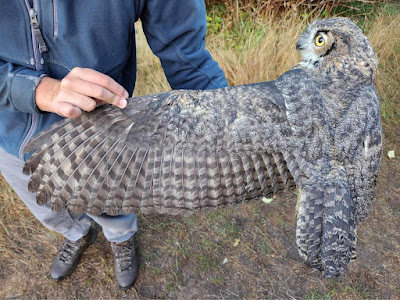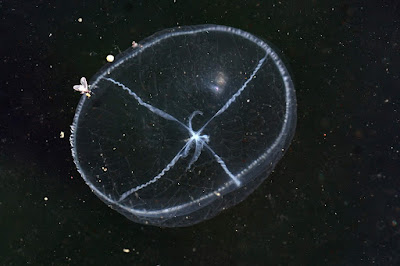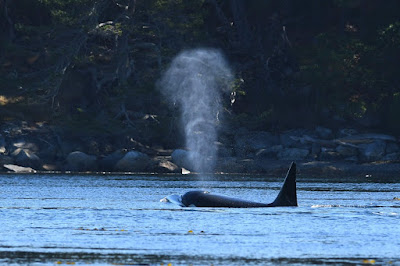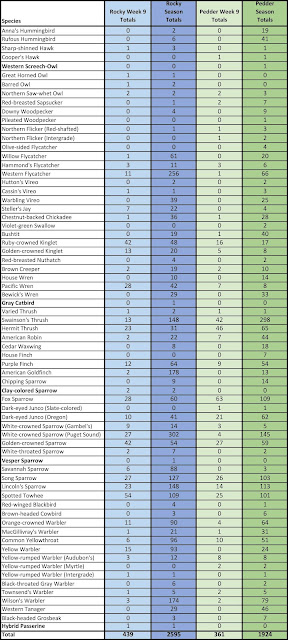 |
| Rising early has its perks! Sunrise at Pedder Bay. (Photo: David Bell) |
As many of you might already know, controlled fires at Rocky Point reduced our regular banding hours this past week, particularly on September 22nd when the banding team had to close the nets after only a few hours of banding. Historically, fires have been common on this landscape - South-East Vancouver Island and the Gulf Islands. The climate here was warmer and drier between 9,000-6,000 years ago, and it is during this period that Garry Oaks arrived along with other species that expanded their range northward. Pollen records show that meadows here were expansive, and many of its species evolved with fire. Such a long time period allowed for some very unique inter-species relationships to evolve. Nature is in fact a network of millions of highly specific interactions like these, some that can only be found here!
The fires help to restore some of the Garry Oak ecosystem plants, particularly the geophytes (like Yampah and Great Camas) and native annuals that are provided with temporary relief from some of the other more competitive species. Fires help reduce the density of native shrubs and young Douglas Fir forests, promoting a more open canopy with widely spaced trees. They also help with controlling species like scotch broom and spurge-laurel (Daphne laureola).
As is typical for this time of year, many of the oak leaves are dry, and the warm fall colours seem to have caught the attention of our winter residents - Pacific Wren, Golden-crowned Sparrow, Fox Sparrow, Ruby-crowned and Golden-crowned Kinglets. As morning breaks you might have heard them tinkering with their vocal instruments.
This week we had mist net closures due to both fire and rain (hence the title) that affected the total number of birds banded. The planned burn at RP on the 22rd, and the rain on September 28th kept nets closed at both stations at the start of the day. At Pedder Bay a total of 277 birds were banded. The most banded birds were Fox Sparrow (47), Golden-crowned Sparrow (40) and Hermit Thrush (23). At Rocky Point 337 birds were banded this week. Spotted Towhee (58) blazed the trail, followed by Golden-crowned Sparrow (48) and Ruby-crowned Kinglets (30) in 3rd - but at the top of the podium for cuteness. Please refer to the table at the end of the post for more detailed statistics.
Some banding highlights this week included White-throated Sparrow, Varied Thrush, Red-breasted Sapsucker, Black-headed Grosbeak and Cooper's Hawk.
 |
| Evan Lewis banding his first raptor, a Cooper's Hawk! (Photo: David Bell) |
 |
| Cooper's Hawk (Photo: David Bell) |
On September 24th at Pedder Bay a Nashville Warbler was banded (3rd record at Pedder Bay, and 10th for RPBO).
 |
| Nashville Warbler (Photo: Evan Lewis) |
And a special capture on the 22nd at Rocky Point was a Chestnut-sided Warbler! 3rd record for RPBO.
 |
| Chestnut-sided Warbler (Photo: David Bell) |
 |
| Emma Radziul had the pleasure of banding the Chestnut-sided Warbler (Photo: Emma Radziul) |
 |
| White-throated Sparrows have been banded at both stations (Photo: David Bell) |
 |
| A great photo showing the eye colour of a sexually dimorphic species - Bushtit (Photo: Adam Ross) |
High above the nets, flocks of Sandhill Cranes, Vaux's Swifts, Cackling, Greater White-fronted, and Canada geese have been heard and seen migrating. Notable observations at the stations this week include Pectoral Sandpiper, Brown Pelican, Lewis's Woodpecker, Lapland Longspur and Northern Waterthrush.
This is a great time and place to hawk watch. Broad-winged, Red-tailed, Sharp-shinned, Coopers Hawks and Turkey Vultures have been seen kettling above the stations regularly. Such sightings often reminds me of a tale that exemplifies the importance of familiarizing oneself with the flight styles of birds.
An article written by C.H. Donald for the Journal of the Bombay Natural History Society in 1952, describes his experience of a falconry exploit on the Indian subcontinent during British India. The writer had secured the services of two local falconers (or bazdars as they were known) and on this occasion, while at 11,000ft above the tree line, his bazdar named Balunda, came to a standstill and said ‘Sahib, what is that?’. A very large and very dark bird above them soared, and C.H. Donald thought it to be an Imperial Eagle. Balunda, a fine falconer who had made his hobby a fine art, disagreed, and admitted he had never seen the bird before. Its flight was entirely different. The bird in question was collected for identification, as was the custom at the time, and Balunda remarked on its large feet and talons, which supplemented his belief that it was not an Imperial Eagle. In an attempt to identify the bird, the specimen was sent to the Bombay Natural History Society. After a long week of suspense the reply came, it was an Imperial Eagle. Not convinced, a request was made for another examination. A reply stating that a committee of the leading ornithologists in India had examined the bird, and it was an Imperial Eagle. Seeing that Balunda was still not satisfied, Donald made another, very polite request to have the bird examined at the Natural History Museum, London, England. Imagine the effort required to have the specimen transported from Bombay to London in those days! Well, it went, and three months later came the reply that the bird was in fact a young Golden Eagle!
Field observations are just as important for us at the banding station as banding birds. Balunda has shown how significant flight style can be as a system of identification, and that multiple identification points can be helpful when identifying a bird, both in the hand and in the field.
Perhaps you will have a chance to watch the raptors migrating and look for a rare Golden Eagle, or join us as we marvel at the intricacies of birds at the station. Thank you to all the volunteers for contributing your time to the station so far. Whether you have been a scribe, extractor, educator, or done census at the station it has all been a great help and we look forward to seeing you again!
 | ||
Band-tailed Pigeons flying above the station. The individual in the centre left of the photograph did right itself! (Photo: Sonja Futehally)
|
 |









































